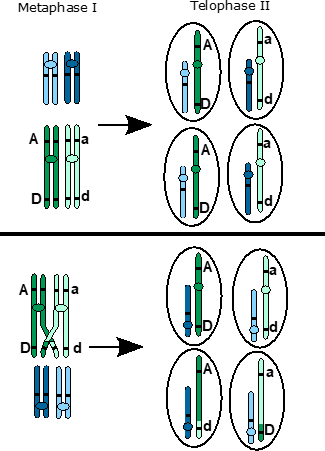2.3 Two Loci on One Chromosome
Based on the description in the last section, it would be expected that if the genes were on the same chromosome the alleles would travel together through meiosis (Figure 2.3.1 top). However, when tested this is not always the case. The recombination of alleles can be explained through the phenomenon of crossing over, which occurs during prophase I.
Crossing over is an exchange between non-sister chromatids that can occur at any position along the entire chromosome. If the two loci that are being considered are sufficiently separated from each other on the chromosome, crossover events can occur between the two loci.
This coupled with the random orientation that the chromosomes align during metaphase I, will allow the other combination of alleles in the gametes (Figure 2.3.1 bottom).
While not shown in Figure 2.3.1, if the two loci are very far apart, multiple crossover events can also take place, further increasing the shuffling of alleles.

The farther apart on the chromosome the more crossover events (Figure 2.3.2) will take place between the two loci. Ultimately, this will result in similar allele combinations to those observed in independent assortment shown above, even if they are on the same chromosome.

If the loci are very close together on the same chromosome, fewer crossovers are likely occur between them. We will not discuss this situation in here, but will do so later on.
Media Attributions
- Figure 2.3.1 Original by L. Canham (2017), CC BY-NC 3.0, Open Genetics Lectures
- Figure 2.3.2 Figure 12 03 04 by Rye et al. (2016), CNX OpenStax, CC BY 4.0, via Wikimedia Commons
References
Canham, L. (2017). Figure 4. Independent assortment as seen on the same chromosome. [digital image]. In Locke, J., Harrington, M., Canham, L. and Min Ku Kang (Eds.), Open Genetics Lectures, Fall 2017 (Chapter 17, p. 2). Dataverse/ BCcampus. http://solr.bccampus.ca:8001/bcc/file/7a7b00f9-fb56-4c49-81a9-cfa3ad80e6d8/1/OpenGeneticsLectures_Fall2017.pdf
Rye, C., Wise, R., Jurukovski, V.,DeSaix, J., Choi, J., & Avissar, Y. (2016, October 21). Figure 11.3 Crossover occurs between non-sister chromatids of homologous chromosomes [digital image]. CNX OpenStax Biology (Chapter 11). https://openstax.org/books/biology/pages/11-1-the-process-of-meiosis
Long Descriptions
- Figure 2.3.1 Crossing over shown using two pairs of homologous chromosomes to demonstrate: one pair colored in two shades of green and the other pair colored in two shades of blue. The positioning of the two pairs of homologous chromosomes is shown during Metaphase I, but without crossing over occurring. The resulting gametes are shown without any recombination. The other pair of homologous chromosomes crossing over is shown to be occurring between non-sister chromatids of a pair of the homologous chromosomes, resulting in recombinant gametes. [Back to Figure 2.3.1]
- Figure 2.3.2 A pair of homologous chromosomes, one colored blue and one colored red are shown crossing over between non-sister chromatids, resulting in recombinant chromosomes alongside non-recombinant chromosomes. [Back to Figure 2.3.2]

